height Citroen DS4 RHD 2011.5 1.G User Guide
[x] Cancel search | Manufacturer: CITROEN, Model Year: 2011.5, Model line: DS4 RHD, Model: Citroen DS4 RHD 2011.5 1.GPages: 396, PDF Size: 12.14 MB
Page 151 of 396

Fittings
Front armrest Comfor t and storage system for the driver and front passenger.
The height and length of the armrest cover can be adjusted.
Longitudinal adjustment
Height adjustment
Storage
�)Raise the cover to the required position (low, intermediate or high). �)If you raise the cover slightly beyond the high position, guide it when lowering it to
the low position.
�) Slide the cover fully for wards or rear wards. The storage space in the armrest can hold up
to 6 CDs.�) Raise the lever. �)
Raise the cover fully.
Page 166 of 396
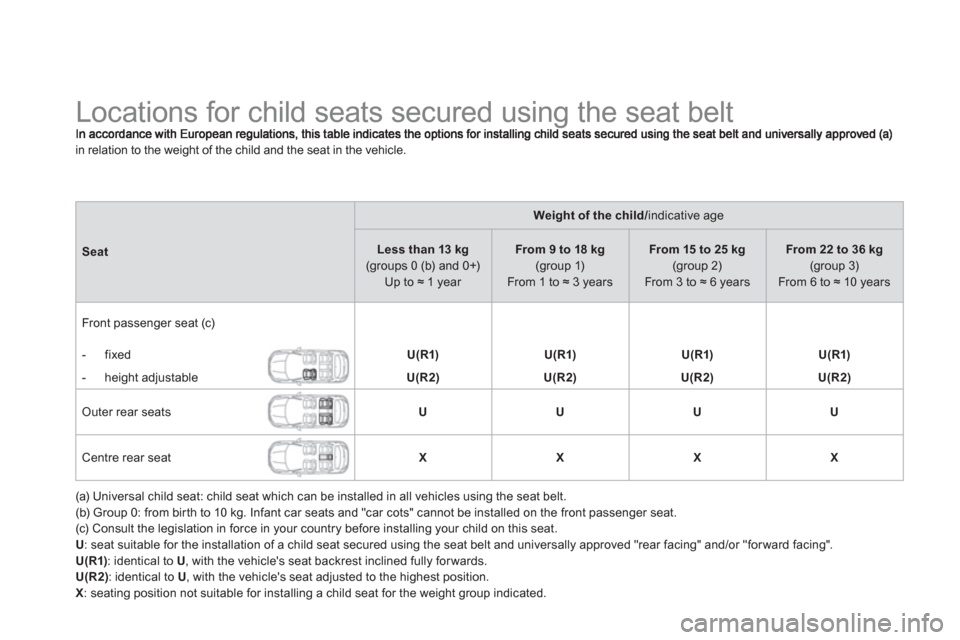
Locations for child seats secured using the seat belt
in relation to the weight of the child and the seat in the vehicle.
Seat
Weight of the child/ indicative age
Less than 13 kg (groups 0 (b) and 0+)Up to ≈ 1 year
From 9 to 18 kg (group 1)From 1 to ≈ 3 years
From 15 to 25 kg(group 2)From 3 to ≈ 6 years
From 22 to 36 kg (group 3)
From 6 to ≈ 10 years
Front passen
ger seat (c)
- fixed
U(R1)U(R1)U(R1)U(R1)
- height adjustableU(R2)U(R2)U(R2)U(R2)
Outer rear seatsUUUU
Centre rear seat XXXX
(a) Universal child seat: child seat which can be installed in all vehicles using the seat belt. (b) Group 0: from birth to 10 kg. Infant car seats and "car cots" cannot be installed on the front passenger seat. (c) Consult the legislation in force in your country before installing your child on this seat.
U
: seat suitable for the installation of a child seat secured using the seat belt and universally approved "rear facing" and/or "forward facing". U(R1): identical to U, with the vehicle's seat backrest inclined fully forwards. U(R2): identical to U, with the vehicle's seat adjusted to the highest position.X
: seating position not suitable for installing a child seat for the weight group indicated.
Page 181 of 396
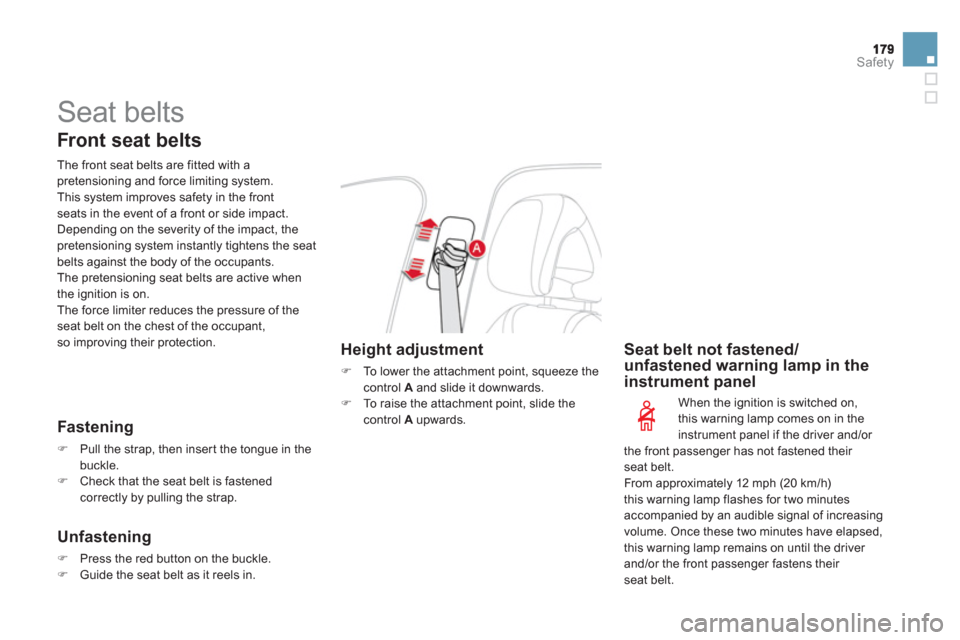
Safety
Seat belts
Front seat belts
The front seat belts are fitted with apretensioning and force limiting system.
This system improves safety in the frontseats in the event of a front or side impact.
Dependin
g on the severity of the impact, thepretensioning system instantly tightens the seat
belts against the body of the occupants.
The pretensioning seat belts are active when
the ignition is on.
The force limiter reduces the pressure of the seat belt on the chest of the occupant, so improving their protection.
Fastening
�)Pull the strap, then inser t the tongue in the buckle.�)Check that the seat belt is fastenedcorrectly by pulling the strap.
Unfastening
�)Press the red button on the buckle.�)Guide the seat belt as it reels in.
Seat belt not fastened/unfastened warning lamp in the instrument panel
When the ignition is switched on,
this warning lamp comes on in the
instrument
panel if the driver and/or
the front passenger has not fastened their seat belt.
From approximately 12 mph (20 km/h)this warning lamp flashes for two minutes
accompanied by an audible signal of increasingvolume. Once these two minutes have elapsed,
this warning lamp remains on until the driver
and/or the front passenger fastens their seat belt.
Height adjustment
�) To lower the attachment point, squeeze thecontrol Aand slide it downwards. �)
To raise the attachment point, slide the control Aupwards.
Page 276 of 396
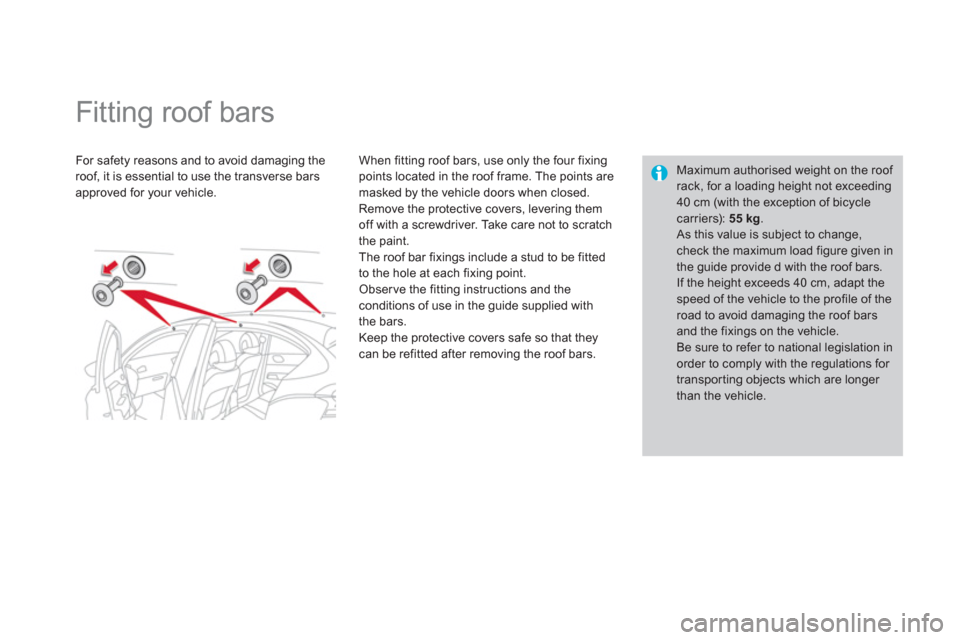
Fitting roof bars
For safety reasons and to avoid damaging the roof, it is essential to use the transverse barsapproved for your vehicle.
When
fitting roof bars, use only the four fixing points located in the roof frame. The points are
masked by the vehicle doors when closed.
Remove the protective covers, levering them
off with a screwdriver. Take care not to scratch
the paint.
The roof bar fixin
gs include a stud to be fitted
to the hole at each fixing point.
Observe the fitting instructions and theconditions of use in the guide supplied with
the bars.
Keep the protective covers safe so that theycan be refitted after removing the roof bars.
Maximum authorised weight on the roof rack, for a loading height not exceeding40 cm (with the exception of bicycle
carriers): 55kg. As this value is subject to change, check the maximum load figure given inthe guide provide d with the roof bars.
If the height exceeds 40 cm, adapt thespeed of the vehicle to the profile of theroad to avoid damaging the roof bars and the fixings on the vehicle.
Be sure to refer to national legislation in order to comply with the regulations for transporting objects which are longer than the vehicle.
Page 338 of 396
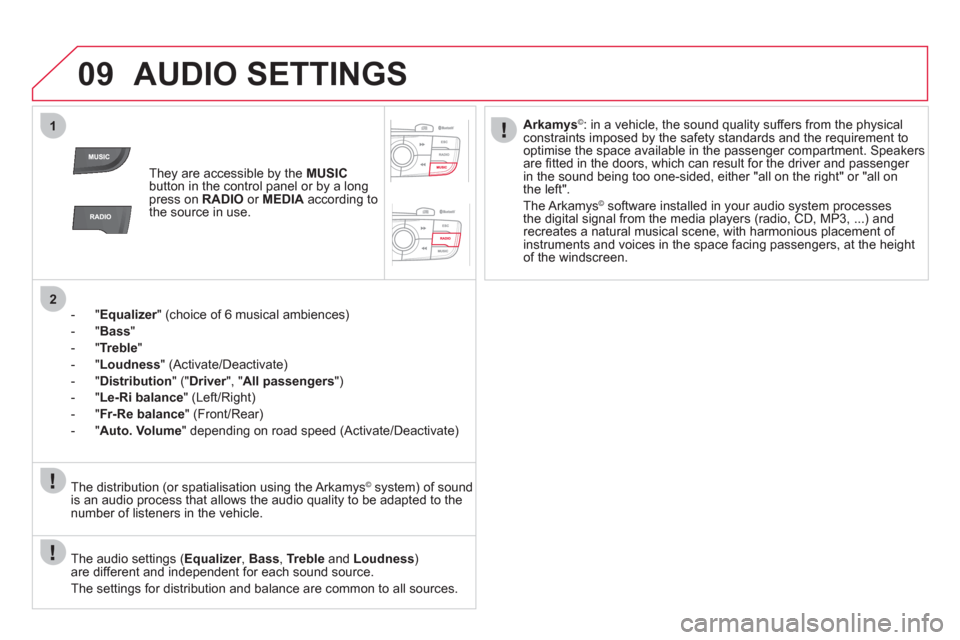
09
1
2
AUDIO SETTINGS
They are accessible by the MUSIC
button in the control panel or by a longpress on RADIO
or MEDIAaccording to
the source in use.
- "
Equalizer" (choice of 6 musical ambiences) r
- " Bass"
- " Trebl
e
"
-"Loudness"
(Activate/Deactivate)
-
"Distribution" (" Driver ", "rAll passengers ")
-
"Le-Ri balance " (Left/Right)
-
" Fr-Re balance
" (Front/Rear)
- " Auto. Volume
" depending on road speed (Activate/Deactivate)
The audio settings ( Equalizer, rBass , Trebleand Loudness)are different and independent for each sound source.
The settings
for distribution and balance are common to all sources. The distribution
(or spatialisation using the Arkamys©system) of sound
is an audio process that allows the audio quality to be adapted to the
number of listeners in the vehicle.
Arkamys©: in a vehicle, the sound quality suffers from the physicalconstraints imposed by the safety standards and the requirement to
optimise the space available in the passenger compartment. Speakersare fi tted in the doors, which can result for the driver and passenger in the sound being too one-sided, either "all on the right" or "all on
the left".
The Arkamys© software installed in your audio system processes ©
the digital signal from the media players (radio, CD, MP3, ...) and
recreates a natural musical scene, with harmonious placement of
instruments and voices in the space facing passengers, at the height of the windscreen.
Page 371 of 396
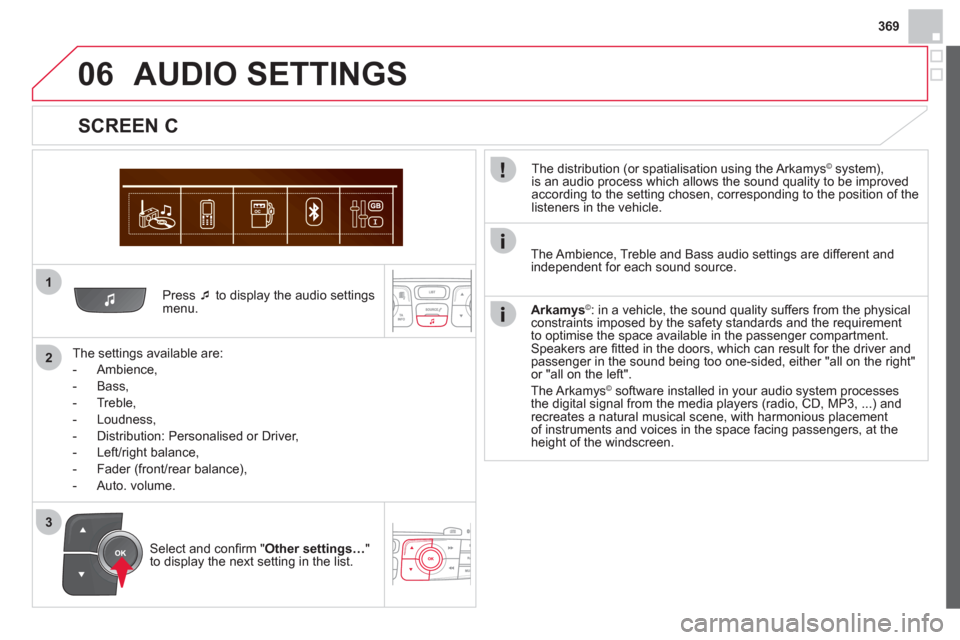
369
1
2
06
3
Press �‘
to display the audio settingsmenu.
The settin
gs available are:
-
Ambience,
- Bass,
-
Treble,
- Loudness,
- Distribution: Personalised or Driver,
- Left/ri
ght balance,
- Fader
(front/rear balance),
-
Auto. volume.
SCREEN C
The distribution (or spatialisation using the Arkamys© system),©
is an audio process which allows the sound quality to be improved
according to the setting chosen, corresponding to the position of the
listeners in the vehicle.
AUDIO SETTINGS
Select and confi rm " Other settings…"
to display the next setting in the list. The Ambience, Treble and Bass audio settin
gs are different andindependent for each sound source.
Arkamys©: in a vehicle, the sound quality suffers from the physicalconstraints imposed by the safety standards and the requirement
to optimise the space available in the passenger compartment. Speakers are fi tted in the doors, which can result for the driver and passenger in the sound being too one-sided, either "all on the right"or "all on the left".
The Arkam
ys© software installed in your audio system processes©
the digital signal from the media players (radio, CD, MP3, ...) and recreates a natural musical scene, with harmonious placement
of instruments and voices in the space facing passengers, at the height of the windscreen.
Page 386 of 396
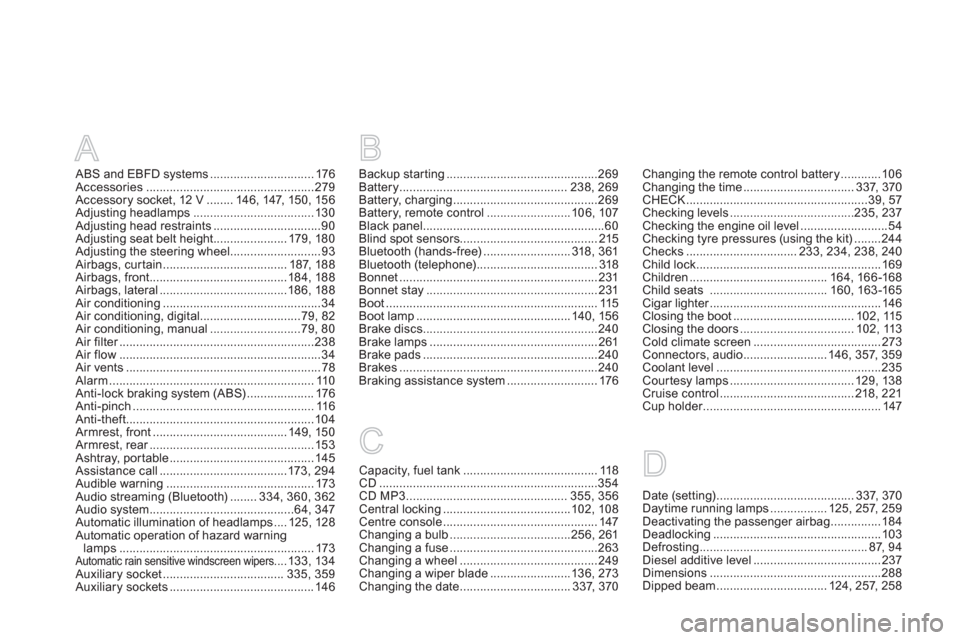
A
ABS and EBFD systems...............................176Accessories..................................................279Accessory socket, 12 V ........146, 147, 150,156Adjusting headlamps....................................130Adjusting head restraints ................................90Adjusting seat belt height ......................179, 180Adjusting the steering wheel...........................93Airbags, curtain.....................................187, 188Airbags, front.........................................184, 188Airbags, lateral......................................186, 188Air conditioning...............................................34Air conditioning, digital ..............................79,82Air conditioning, manual ...........................79,80Air filter..........................................................r238Air flow............................................................34Air vents ..........................................................78Alarm.............................................................110Anti-lock braking system (ABS)....................176Anti-pinch......................................................116Anti-theft........................................................104Armrest, front........................................149,150Armrest, rear.................................................r153Ashtray, por table...........................................145Assistance call ......................................173,294Audible warning ............................................ 173Audio streaming (Bluetooth)........334, 360, 362Audio system...........................................64, 347Automatic illumination of headlamps....125, 128Automatic operation of hazard warninglamps..........................................................173Automatic rain sensitive windscreen wipers....133,134Auxiliary socket ....................................335, 359Auxiliary sockets ...........................................146
Backup starting.............................................269Battery..................................................238, 269Battery, charging...........................................269Battery, remote control.........................106,107Black panel......................................................60Blind spot sensors.........................................215Bluetooth (hands-free)..........................318,361Bluetooth (telephone)....................................318Bonnet...........................................................231Bonnet stay...................................................231Boot...............................................................115Boot lamp..............................................140, 156Brake discs ....................................................240Brake lamps ..................................................261Brake pads ....................................................240Brakes ...........................................................240Braking assistance system...........................176
Capacity, fuel tank ........................................118CD .................................................................354CD MP3................................................355, 356Central locking......................................102,108Centre console..............................................147Changing a bulb....................................256,261Changing a fuse ............................................263Changing a wheel .........................................249Changing a wiper blade ........................136,273Changing the date.................................337, 370
Changing the remote control battery............106Changing the time.................................337,370CHECK......................................................39, 57Checking levels .....................................235,237Checking the engine oil level..........................54Checking tyre pressures (using the kit)........244Checks ................................. 233, 234, 238,240Child lock.......................................................169Children.........................................164, 166-168Child seats ...................................160,163-165Cigar lighter...................................................r146Closing the boot ....................................102, 115Closing the doors ..................................102,113Cold climate screen......................................273Connectors, audio .........................146,357, 359Coolant level.................................................235Courtesy lamps.....................................129, 138Cruise control........................................218,221Cup holder.....................................................r147
B
C
Date (setting).........................................337,370Daytime running lamps.................125,257, 259Deactivating the passenger airbag...............184Deadlocking..................................................103Defrosting ..................................................87, 94
Diesel additive level......................................237Dimensions...................................................288Dipped beam .................................124, 257, 258
D
Page 387 of 396
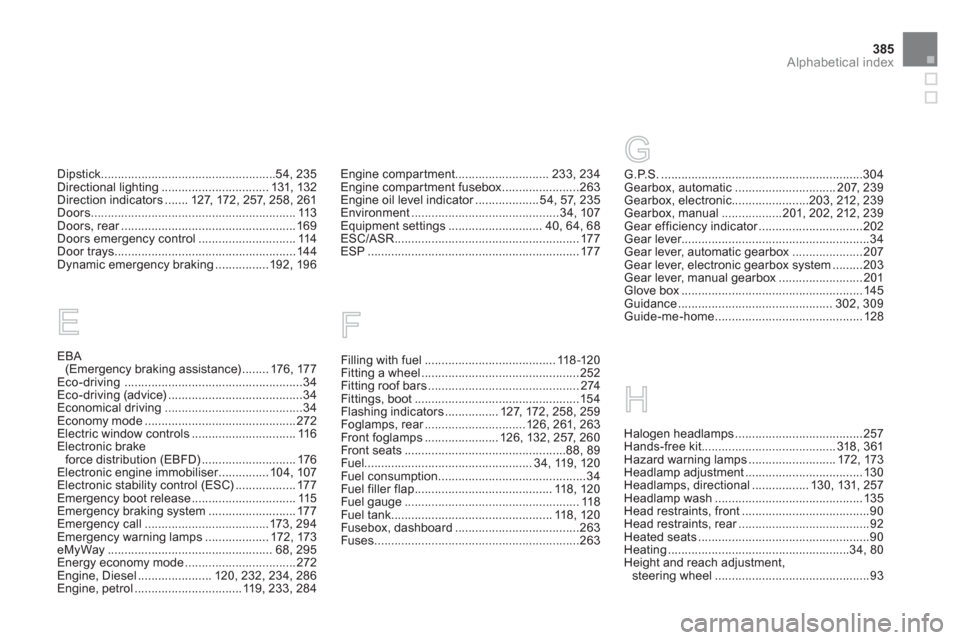
385
Alphabetical index
Dipstick....................................................54,235Directional lighting................................131, 132Direction indicators.......127,172,257,258,261Doors.............................................................113Doors, rear....................................................r169Doors emergency control .............................114
Door trays...................................................... 144
Dynamic emergency braking................192, 196
EBA(Emergency braking assistance)........ 176,177Eco-driving.....................................................34Eco-driving (advice)........................................34Economical driving .........................................34Economy mode.............................................272Electric window controls ...............................116Electronic brake
force distribution (EBFD)............................176Electronic engine immobiliser...............r104, 107Electronic stability control (ESC).................. 177Emergency boot release...............................115Emergency braking system..........................177Emergency call.....................................173, 294Emergency warning lamps...................172, 173eMyWay .................................................68,295Energy economy mode .................................272Engine, Diesel ......................120, 232, 234, 286Engine, petrol ................................ 119,233, 284
Engine compartment............................233,234Engine compartment fusebox.......................263Engine oil level indicator...................r54,57, 235Environment............................................34,107Equipment settings ............................40,64, 68ESC/ASR .......................................................177ESP ............................................................... 177
EG
G.P.S.............................................................304Gearbox, automatic.............................. 207,239Gearbox, electronic.......................203,212,239Gearbox, manual..................201,202,212,239Gear efficiency indicator...............................r202Gear lever........................................................34Gear lever, automatic gearbox.....................207Gear lever, electronic gearbox system.........203Gear lever, manual gearbox.........................201Glove box......................................................145Guidance ..............................................302, 309Guide-me-home............................................128
Filling with fuel ....................................... 118-120Fitting a wheel ............................................... 252Fitting roof bars.............................................274Fittings, boot.................................................154Flashing indicators................127, 172, 258,259Foglamps, rear..............................r126,261, 263Front foglamps ......................126, 132,257,260Front seats................................................88,89Fuel..................................................34,119, 120Fuel consumption............................................34Fuel filler flap.........................................118, 120Fuel gauge....................................................118Fuel tank................................................118, 120Fusebox, dashboard.....................................263Fuses.............................................................263
F
Halogen headlamps......................................257Hands-free kit........................................318,361Hazard warning lamps ..........................172, 173Headlamp adjustment ...................................130Headlamps, directional.................130, 131,257Headlamp wash............................................135Head restraints, front ......................................90Head restraints, rear.......................................r92Heated seats...................................................90Heating......................................................34, 80Height and reach adjustment,steering wheel ..............................................93
H